抗体的亲和力与亲合力
抗体亲和力与亲合力的区别AffinityandAvidityofAntibodies.pdf
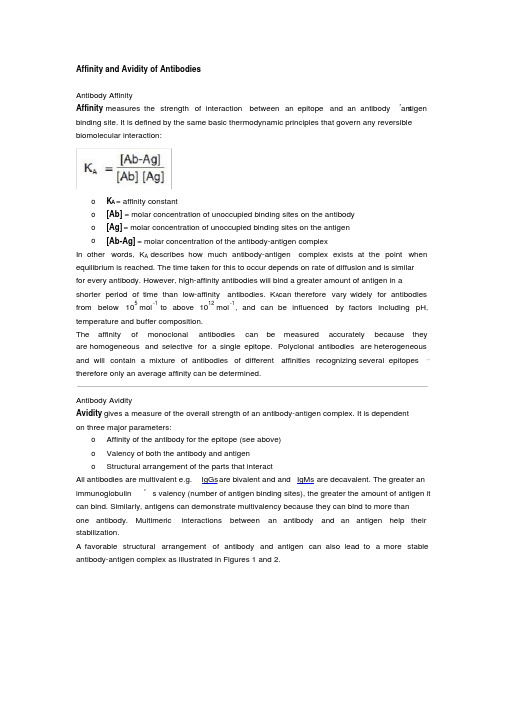
Affinity and Avidity of AntibodiesAntibody Affinityantigen Affinity measures the strength of interaction between an epitope and an antibody’s binding site. It is defined by the same basic thermodynamic principles that govern any reversible biomolecular interaction:o K A = affinity constanto[Ab] = molar concentration of unoccupied binding sites on the antibodyo[Ag] = molar concentration of unoccupied binding sites on the antigeno[Ab-Ag] = molar concentration of the antibody-antigen complexIn other words, K A describes how much antibody-antigen complex exists at the point when equilibrium is reached. The time taken for this to occur depends on rate of diffusion and is similarfor every antibody. However, high-affinity antibodies will bind a greater amount of antigen in a shorter period of time than low-affinity antibodies. K A can therefore vary widely for antibodies from below 105 mol-1 to above 1012 mol-1, and can be influenced by factors including pH, temperature and buffer composition.The affinity of monoclonal antibodies can be measured accurately because they are homogeneous and selective for a single epitope. Polyclonal antibodies are heterogeneous and will contain a mixture of antibodies of different affinities recognizing several epitopes –therefore only an average affinity can be determined.Antibody AvidityAvidity gives a measure of the overall strength of an antibody-antigen complex. It is dependenton three major parameters:o Affinity of the antibody for the epitope (see above)o Valency of both the antibody and antigeno Structural arrangement of the parts that interactAll antibodies are multivalent e.g. IgGs are bivalent and and IgMs are decavalent. The greater an immunoglobulin’s valency (number of antigen binding sites), the greater the amount of antigen it can bind. Similarly, antigens can demonstrate multivalency because they can bind to more thanone antibody. Multimeric interactions between an antibody and an antigen help their stabilization.A favorable structural arrangement of antibody and antigen can also lead to a more stable antibody-antigen complex as illustrated in Figures 1 and 2.Figure 1. An immobilized antigen (a high local concentration of available epitopes) provides more opportunity for the antibody-antigen complex to form than free antigen in solution over the same time period. Once the first antigen binding arm of an antibody attaches to an antigen on a solid support, the chances of a bivalent interaction are greatly improved. Many immunoassays like Western blotting and ELISA exploit this principle.Figure 2. When an antigen is mixed with a polyclonal antibody, multivalent interactions may leadto large, stable (high avidity) structures being formed. This is because the antigen may be boundby several antibodies, each recognizing a different epitope. Polyclonal antibodies are therefore ideal for immunoprecipitation experiments.Further Useful Readingo How we improve the affinity of our recombinant monoclonal antibodies generated using HuCAL? technology through affinity maturation。
抗原抗体结合的影响因素
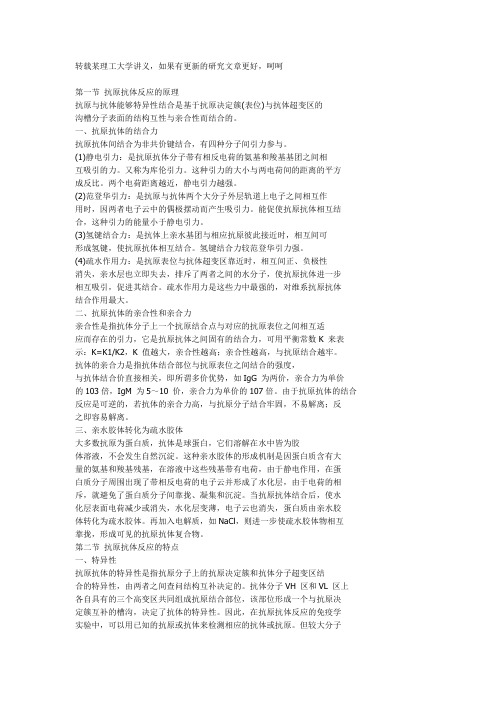
转载某理工大学讲义,如果有更新的研究文章更好,呵呵第一节抗原抗体反应的原理抗原与抗体能够特异性结合是基于抗原决定簇(表位)与抗体超变区的沟槽分子表面的结构互性与亲合性而结合的。
一、抗原抗体的结合力抗原抗体间结合为非共价键结合,有四种分子间引力参与。
(1)静电引力:是抗原抗体分子带有相反电荷的氨基和羧基基团之间相互吸引的力。
又称为库伦引力。
这种引力的大小与两电荷间的距离的平方成反比。
两个电荷距离越近,静电引力越强。
(2)范登华引力:是抗原与抗体两个大分子外层轨道上电子之间相互作用时,因两者电子云中的偶极摆动而产生吸引力。
能促使抗原抗体相互结合,这种引力的能量小于静电引力。
(3)氢键结合力:是抗体上亲水基团与相应抗原彼此接近时,相互间可形成氢键,使抗原抗体相互结合。
氢键结合力较范登华引力强。
(4)疏水作用力:是抗原表位与抗体超变区靠近时,相互间正、负极性消失,亲水层也立即失去,排斥了两者之间的水分子,使抗原抗体进一步相互吸引,促进其结合。
疏水作用力是这些力中最强的,对维系抗原抗体结合作用最大。
二、抗原抗体的亲合性和亲合力亲合性是指抗体分子上一个抗原结合点与对应的抗原表位之间相互适应而存在的引力,它是抗原抗体之间固有的结合力,可用平衡常数K 来表示:K=K1/K2,K 值越大,亲合性越高;亲合性越高,与抗原结合越牢。
抗体的亲合力是指抗体结合部位与抗原表位之间结合的强度,与抗体结合价直接相关,即所谓多价优势,如IgG 为两价,亲合力为单价的103倍,IgM 为5~10 价,亲合力为单价的107倍。
由于抗原抗体的结合反应是可逆的,若抗体的亲合力高,与抗原分子结合牢固,不易解离;反之即容易解离。
三、亲水胶体转化为疏水胶体大多数抗原为蛋白质,抗体是球蛋白,它们溶解在水中皆为胶体溶液,不会发生自然沉淀。
这种亲水胶体的形成机制是因蛋白质含有大量的氨基和羧基残基,在溶液中这些残基带有电荷,由于静电作用,在蛋白质分子周围出现了带相反电荷的电子云并形成了水化层,由于电荷的相斥,就避免了蛋白质分子间靠拢、凝集和沉淀。
抗体亲和力与亲合力的区别Affinity and Avidity of Antibodies

Affinity and Avidity of AntibodiesAntibody AffinityAffinity measures the strength of interaction between an epitope and an antibody’s antigen binding site. It is defined by the same basic thermodynamic principles that govern any reversible biomolecular interaction:o K A= affinity constanto[Ab]= molar concentration of unoccupied binding sites on the antibodyo[Ag]= molar concentration of unoccupied binding sites on the antigeno[Ab-Ag]= molar concentration of the antibody-antigen complexIn other words, K A describes how much antibody-antigen complex exists at the point when equilibrium is reached. The time taken for this to occur depends on rate of diffusion and is similar for every antibody. However, high-affinity antibodies will bind a greater amount of antigen in a shorter period of time than low-affinity antibodies. K A can therefore vary widely for antibodies from below 105mol-1to above 1012mol-1, and can be influenced by factors including pH, temperature and buffer composition.The affinity of monoclonal antibodies can be measured accurately because they are homogeneous and selective for a single epitope. Polyclonal antibodies are heterogeneous and will contain a mixture of antibodies of different affinities recognizing several epitopes – therefore only an average affinity can be determined.Antibody AvidityAvidity gives a measure of the overall strength of an antibody-antigen complex. It is dependent on three major parameters:o Affinity of the antibody for the epitope (see above)o Valency of both the antibody and antigeno Structural arrangement of the parts that interactAll antibodies are multivalent e.g.IgGs are bivalent and and IgMs are decavalent. The greater an immunoglobulin’s valency (number of antigen binding sites), the greater the amount of antigen it can bind. Similarly, antigens can demonstrate multivalency because they can bind to more than one antibody. Multimeric interactions between an antibody and an antigen help their stabilization.A favorable structural arrangement of antibody and antigen can also lead to a more stable antibody-antigen complex as illustrated in Figures 1 and 2.Figure 1.An immobilized antigen (a high local concentration of available epitopes) provides more opportunity for the antibody-antigen complex to form than free antigen in solution over the same time period. Once the first antigen binding arm of an antibody attaches to an antigen on a solid support, the chances of a bivalent interaction are greatly improved. Many immunoassays like Western blotting and ELISA exploit this principle.Figure 2.When an antigen is mixed with a polyclonal antibody, multivalent interactions may lead to large, stable (high avidity) structures being formed. This is because the antigen may be bound by several antibodies, each recognizing a different epitope. Polyclonal antibodies are therefore ideal for immunoprecipitation experiments.Further Useful Readingo How we improve the affinity of our recombinant monoclonal antibodies generated using HuCAL® technology through affinity maturation。
亲和力的医学名词解释
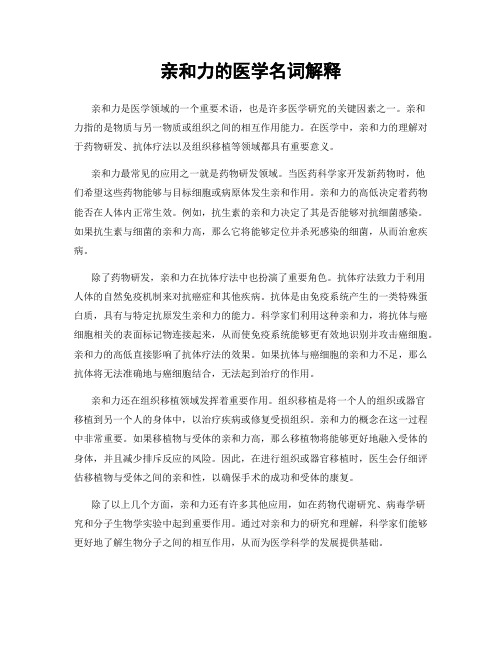
亲和力的医学名词解释亲和力是医学领域的一个重要术语,也是许多医学研究的关键因素之一。
亲和力指的是物质与另一物质或组织之间的相互作用能力。
在医学中,亲和力的理解对于药物研发、抗体疗法以及组织移植等领域都具有重要意义。
亲和力最常见的应用之一就是药物研发领域。
当医药科学家开发新药物时,他们希望这些药物能够与目标细胞或病原体发生亲和作用。
亲和力的高低决定着药物能否在人体内正常生效。
例如,抗生素的亲和力决定了其是否能够对抗细菌感染。
如果抗生素与细菌的亲和力高,那么它将能够定位并杀死感染的细菌,从而治愈疾病。
除了药物研发,亲和力在抗体疗法中也扮演了重要角色。
抗体疗法致力于利用人体的自然免疫机制来对抗癌症和其他疾病。
抗体是由免疫系统产生的一类特殊蛋白质,具有与特定抗原发生亲和力的能力。
科学家们利用这种亲和力,将抗体与癌细胞相关的表面标记物连接起来,从而使免疫系统能够更有效地识别并攻击癌细胞。
亲和力的高低直接影响了抗体疗法的效果。
如果抗体与癌细胞的亲和力不足,那么抗体将无法准确地与癌细胞结合,无法起到治疗的作用。
亲和力还在组织移植领域发挥着重要作用。
组织移植是将一个人的组织或器官移植到另一个人的身体中,以治疗疾病或修复受损组织。
亲和力的概念在这一过程中非常重要。
如果移植物与受体的亲和力高,那么移植物将能够更好地融入受体的身体,并且减少排斥反应的风险。
因此,在进行组织或器官移植时,医生会仔细评估移植物与受体之间的亲和性,以确保手术的成功和受体的康复。
除了以上几个方面,亲和力还有许多其他应用,如在药物代谢研究、病毒学研究和分子生物学实验中起到重要作用。
通过对亲和力的研究和理解,科学家们能够更好地了解生物分子之间的相互作用,从而为医学科学的发展提供基础。
尽管亲和力在医学领域扮演着重要角色,但亲和力的研究也面临一些挑战和限制。
首先,亲和力的测定往往是一项复杂的任务,需要使用特殊的实验设备和技术。
其次,亲和力的研究结果受到许多因素的影响,如温度、PH值和离子浓度等。
亲合力

谢谢观看
尿素处理时间长短可影响AI的高低,尤其是低AI的标本会因为变性时间不足而得出明显高于真实的AI值。国 内的研究在检测抗HCMV-IgG AI时多采用简化的洗脱法,认为取50%为判断近期原发感染的界值。经比较2种方法 分别检测8份血浆的结果,温育法检测的AI低于洗脱法,但无显著性差异,说明温育法(变性孔尿素终浓度4mol/L) 与该洗脱法具有相近的使低亲合力抗体变性的能力。由此本研究采用Hedman对于AI的解释,以AI<30%判断近期原 发感染,以AI>30%排除近期原发感染,判断为既往感染或再发感染。
抗HCMV-IgG浓度过高时包被抗原相对不足,存在过剩的IgG,此时由于高亲合力的IgG在尿素的作用下仍然能 与包被抗原结合,而非变性孔IgG与包被抗原的结合已经饱和,所测得的A值相对恒定,因此影响AI测定,得出较 高的AI值。这与K li-mashevskaya等的报道一致。而Dangel等却认为高浓度的IgG会引起错误的低AI值结果,可 能与实验方法及试剂的不同有关。而在检测血浆抗HC-MV-IgG浓度约100 IU/mL的AI时,AI值随稀释倍数不同出 现一定的波动,但不影响结果的判断。
HSCs是肝纤维化形成过程中合成细胞外基质的最主要细胞,肝纤维化恢复期,凋亡的HSCs明显增多。实验证 明,在CCl4造成大鼠肝纤维化模型后的自动恢复过程中,HSCs凋亡是中心事件。所以,抑制HSCs增殖、诱导其凋 亡是抗肝纤维化的重要策略。Takahashi等报道,NGFR是细胞膜受体,存在于多种细胞表面。
抗体的亲和力与亲合力.pdf
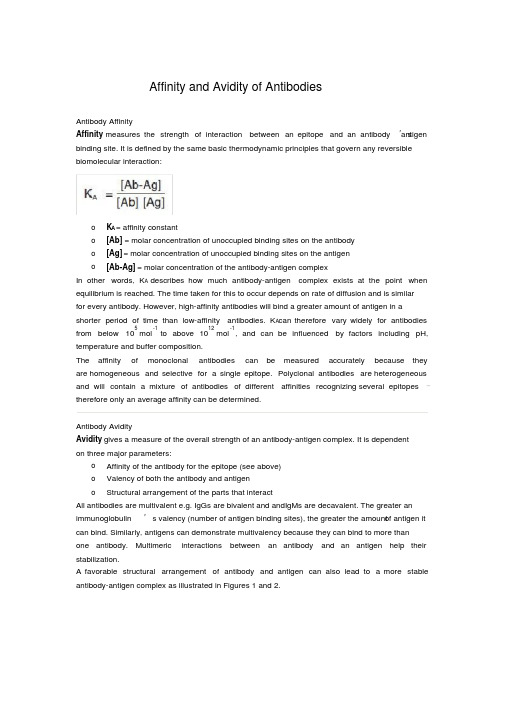
Affinity and Avidity of AntibodiesAntibody Affinityantigen Affinity measures the strength of interaction between an epitope and an antibody’s binding site. It is defined by the same basic thermodynamic principles that govern any reversible biomolecular interaction:o K A = affinity constanto[Ab] = molar concentration of unoccupied binding sites on the antibodyo[Ag] = molar concentration of unoccupied binding sites on the antigeno[Ab-Ag] = molar concentration of the antibody-antigen complexIn other words, K A describes how much antibody-antigen complex exists at the point when equilibrium is reached. The time taken for this to occur depends on rate of diffusion and is similarfor every antibody. However, high-affinity antibodies will bind a greater amount of antigen in a shorter period of time than low-affinity antibodies. K A can therefore vary widely for antibodies from below 105 mol-1 to above 1012 mol-1, and can be influenced by factors including pH, temperature and buffer composition.The affinity of monoclonal antibodies can be measured accurately because they are homogeneous and selective for a single epitope. Polyclonal antibodies are heterogeneous and will contain a mixture of antibodies of different affinities recognizing several epitopes –therefore only an average affinity can be determined.Antibody AvidityAvidity gives a measure of the overall strength of an antibody-antigen complex. It is dependenton three major parameters:o Affinity of the antibody for the epitope (see above)o Valency of both the antibody and antigeno Structural arrangement of the parts that interactAll antibodies are multivalent e.g. IgGs are bivalent and andIgMs are decavalent. The greater an immunoglobulin’s valency (number of antigen binding sites), the greater the amount of antigen it can bind. Similarly, antigens can demonstrate multivalency because they can bind to more thanone antibody. Multimeric interactions between an antibody and an antigen help their stabilization.A favorable structural arrangement of antibody and antigen can also lead to a more stable antibody-antigen complex as illustrated in Figures 1 and 2.Figure 1. An immobilized antigen (a high local concentration of available epitopes) provides more opportunity for the antibody-antigen complex to form than free antigen in solution over the same time period. Once the first antigen binding arm of an antibody attaches to an antigen on a solid support, the chances of a bivalent interaction are greatly improved. Many immunoassays like Western blotting and ELISA exploit this principle.Figure 2. When an antigen is mixed with a polyclonal antibody, multivalent interactions may leadto large, stable (high avidity) structures being formed. This is because the antigen may be boundby several antibodies, each recognizing a different epitope. Polyclonal antibodies are therefore ideal for immunoprecipitation experiments.Further Useful ReadingHow we improve the affinity of our recombinant monoclonal antibodies generated usingHuCAL technology through affinity maturation。
临床免疫学检验名词解释重要知识点上

抗原抗体反应:是指抗原与相应抗体在体内或体外发生的特异性结合反应。
抗原抗体间的结合力涉及静电引力、范德华力、氢键和疏水作用力,其中疏水作用力最强,它是在水溶液中两个疏水基团相互接触,由于对水分子的排斥而趋向聚集的力。
亲和性(affinity):是指抗体分子上一个抗原结合点与一个相应抗原表位(AD)之间的结合强度,取决于两者空间结构的互补程度。
亲合力(avidity):是指一个完整抗体分子的抗原结合部位与若干相应抗原表位之间的结合强度,它与亲和性、抗体的结合价、抗原的有效AD数目有关。
抗原抗体反应的特点:特异性、可逆性、比例性、阶段性。
带现象(zone phenomenon):一种抗原-抗体反应的现象。
在凝集反应或沉淀反应中,由于抗体过剩或抗原过剩,抗原与抗体结合但不能形成大的复合物,从而不出现肉眼可见的反应现象。
抗体过量称为前带,抗原过量称为后带。
免疫原(immunogen):是指能诱导机体免疫系统产生特异性抗体或致敏淋巴细胞的抗原。
免疫佐剂(immuno adjustvant):简称佐剂,是指某些预先或与抗原同时注入体内,可增强机体对该抗原的免疫应答或改变免疫应答类型的物质。
半抗原(hapten):又称不完全抗原,是指仅具有与抗体结合的能力(抗原性),而单独不能诱导抗体产生(无免疫原性)的物质。
当半抗原与蛋白质载体结合后即可成为完全抗原。
载体(carrier):结合后能给予半抗原以免疫原性的物质。
载体效应:初次免疫与再次免疫时,只有使半抗原结合在同一载体上,才能使机体产生对半抗原的免疫应答,该现象称为~。
单克隆抗体(McAB):将单个B细胞分离出来,加以增殖形成一个克隆群落,该B细胞克隆产生的针对单一表位、结构相同、功能均一的抗体,即~。
多克隆抗体(PcAb):天然抗原分子中常含多种不同抗原特异性的抗原表位,以该抗原物质刺激机体免疫系统,体内多个B细胞克隆被激活,产生含有针对不同抗原表位的免疫球蛋白,即~基因工程抗体(GEAb):是利用DNA重组及蛋白工程技术,从基因水平对编码抗体的基因进行改造和装配,经导入适当的受体细胞后重新表达的抗体。
简述抗体的基本结构

简述抗体的基本结构抗体是一种由蛋白质组成的分子,也称为免疫球蛋白。
它在免疫系统中起着至关重要的作用,能够识别并结合到体内外的抗原上,从而参与免疫应答的调节和效应。
抗体的基本结构可以分为四个区域:两个相同的轻链(light chain)和两个相同的重链(heavy chain)。
轻链和重链通过二硫键连接在一起,形成了Y形结构。
每个抗体分子都有两个臂和一个柄。
臂部位于抗体的顶端,具有抗原识别和结合的功能;柄部位于抗体的底部,具有效应分子结合的功能。
轻链是由单个多肽链组成的,重链则由两个多肽链组成。
轻链和重链都由一系列的可变区(variable region)和恒定区(constant region)组成。
可变区的序列在不同的抗体中具有高度的变异性,决定了抗体的特异性和亲和力。
恒定区的序列相对保守,决定了抗体的功能和效应。
抗体的可变区包括特异性决定区(hypervariable region),也称为CDR。
CDR位于可变区的末端,由三个短序列组成,分别命名为CDR1、CDR2和CDR3。
CDR通过氢键、疏水作用和范德华力等相互作用与抗原结合,形成抗原-抗体复合物。
抗体的恒定区在不同的抗体类别中有所不同,包括IgG、IgM、IgA、IgD和IgE等。
每种抗体类别具有不同的功能和在免疫反应中的作用。
例如,IgG是最常见的抗体类别,具有长时间的循环寿命和多种效应分子结合的能力;IgM是第一次免疫应答产生的主要抗体类别,具有较高的亲和力和多价结合能力。
在人体内,抗体由B淋巴细胞(B lymphocyte)产生。
当机体遇到外来的抗原时,B淋巴细胞会受到激活,开始分泌抗体。
这个过程称为免疫应答。
一旦抗体与抗原结合,它们可以通过多种机制来识别和清除抗原,包括中和病原体、激活补体系统、调节免疫细胞的活化等。
抗体的结构和功能使其成为疾病诊断和治疗的重要工具。
通过检测体液中的抗体水平,可以确定感染病原体的存在,并评估免疫系统对其的应答情况。
抗体抗体的多样性及其产生机制
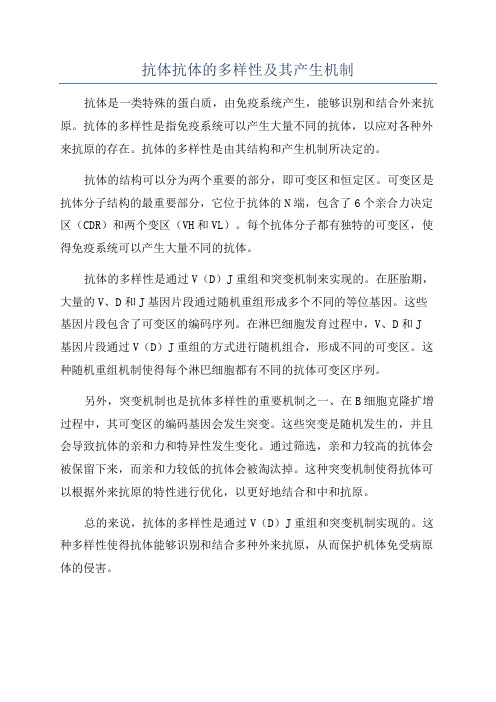
抗体抗体的多样性及其产生机制
抗体是一类特殊的蛋白质,由免疫系统产生,能够识别和结合外来抗原。
抗体的多样性是指免疫系统可以产生大量不同的抗体,以应对各种外来抗原的存在。
抗体的多样性是由其结构和产生机制所决定的。
抗体的结构可以分为两个重要的部分,即可变区和恒定区。
可变区是抗体分子结构的最重要部分,它位于抗体的N端,包含了6个亲合力决定区(CDR)和两个变区(VH和VL)。
每个抗体分子都有独特的可变区,使得免疫系统可以产生大量不同的抗体。
抗体的多样性是通过V(D)J重组和突变机制来实现的。
在胚胎期,大量的V、D和J基因片段通过随机重组形成多个不同的等位基因。
这些基因片段包含了可变区的编码序列。
在淋巴细胞发育过程中,V、D和J 基因片段通过V(D)J重组的方式进行随机组合,形成不同的可变区。
这种随机重组机制使得每个淋巴细胞都有不同的抗体可变区序列。
另外,突变机制也是抗体多样性的重要机制之一、在B细胞克隆扩增过程中,其可变区的编码基因会发生突变。
这些突变是随机发生的,并且会导致抗体的亲和力和特异性发生变化。
通过筛选,亲和力较高的抗体会被保留下来,而亲和力较低的抗体会被淘汰掉。
这种突变机制使得抗体可以根据外来抗原的特性进行优化,以更好地结合和中和抗原。
总的来说,抗体的多样性是通过V(D)J重组和突变机制实现的。
这种多样性使得抗体能够识别和结合多种外来抗原,从而保护机体免受病原体的侵害。
抗原抗体结合的亲和力
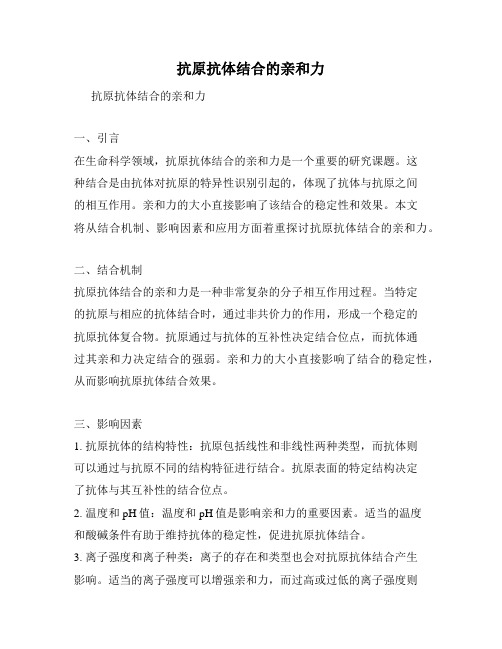
抗原抗体结合的亲和力抗原抗体结合的亲和力一、引言在生命科学领域,抗原抗体结合的亲和力是一个重要的研究课题。
这种结合是由抗体对抗原的特异性识别引起的,体现了抗体与抗原之间的相互作用。
亲和力的大小直接影响了该结合的稳定性和效果。
本文将从结合机制、影响因素和应用方面着重探讨抗原抗体结合的亲和力。
二、结合机制抗原抗体结合的亲和力是一种非常复杂的分子相互作用过程。
当特定的抗原与相应的抗体结合时,通过非共价力的作用,形成一个稳定的抗原抗体复合物。
抗原通过与抗体的互补性决定结合位点,而抗体通过其亲和力决定结合的强弱。
亲和力的大小直接影响了结合的稳定性,从而影响抗原抗体结合效果。
三、影响因素1. 抗原抗体的结构特性:抗原包括线性和非线性两种类型,而抗体则可以通过与抗原不同的结构特征进行结合。
抗原表面的特定结构决定了抗体与其互补性的结合位点。
2. 温度和pH值:温度和pH值是影响亲和力的重要因素。
适当的温度和酸碱条件有助于维持抗体的稳定性,促进抗原抗体结合。
3. 离子强度和离子种类:离子的存在和类型也会对抗原抗体结合产生影响。
适当的离子强度可以增强亲和力,而过高或过低的离子强度则会影响抗原抗体结合。
四、应用方面抗原抗体结合的亲和力在许多领域中具有广泛的应用价值。
以生物医学为例,亲和力可以用于抗体治疗以及疾病的诊断和监测。
此外,亲和力还可以用于生物工程领域的蛋白质纯化和分离。
通过调控抗原抗体结合的亲和力,可以实现对特定分子的高效识别和分离。
五、总结抗原抗体结合的亲和力是一个关键的生命科学课题。
它不仅涉及到抗体的结构和特性,还与环境因素密切相关。
了解亲和力的影响因素,可以帮助我们更好地理解抗原抗体结合的机制,更好地应用于生物医学和生物工程领域。
随着技术的不断进步,我们相信抗原抗体结合亲和力的研究将会为我们探索更多的应用和发现带来新的机遇和挑战。
以上便是对抗原抗体结合亲和力的简要阐述。
希望本文能帮助读者理解抗原抗体结合亲和力的重要性及其应用价值。
抗体ec50亲和力解读
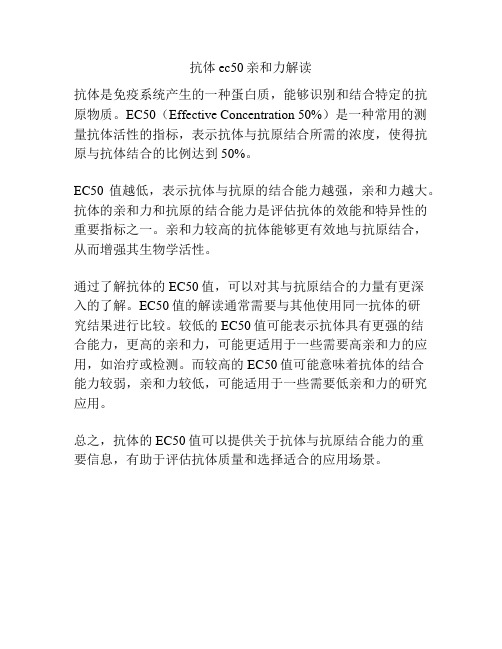
抗体ec50亲和力解读
抗体是免疫系统产生的一种蛋白质,能够识别和结合特定的抗原物质。
EC50(Effective Concentration 50%)是一种常用的测量抗体活性的指标,表示抗体与抗原结合所需的浓度,使得抗原与抗体结合的比例达到50%。
EC50值越低,表示抗体与抗原的结合能力越强,亲和力越大。
抗体的亲和力和抗原的结合能力是评估抗体的效能和特异性的重要指标之一。
亲和力较高的抗体能够更有效地与抗原结合,从而增强其生物学活性。
通过了解抗体的EC50值,可以对其与抗原结合的力量有更深
入的了解。
EC50值的解读通常需要与其他使用同一抗体的研
究结果进行比较。
较低的EC50值可能表示抗体具有更强的结
合能力,更高的亲和力,可能更适用于一些需要高亲和力的应用,如治疗或检测。
而较高的EC50值可能意味着抗体的结合
能力较弱,亲和力较低,可能适用于一些需要低亲和力的研究应用。
总之,抗体的EC50值可以提供关于抗体与抗原结合能力的重
要信息,有助于评估抗体质量和选择适合的应用场景。
抗体亲和力成熟的机制

抗体亲和力成熟的机制抗体亲和力成熟是指抗体在机体内经过一系列的发育和选择过程,逐渐提高与抗原结合的亲和力。
这一过程在免疫系统的发育和功能发挥中起着重要作用。
本文将从抗体的产生、成熟和选择三个方面来探讨抗体亲和力成熟的机制。
抗体的产生是抗体亲和力成熟的第一步。
在机体内,B淋巴细胞是主要负责产生抗体的细胞。
当机体受到外来抗原的侵袭后,这些抗原将被摄取和加工,并与B细胞的表面抗体结合。
这种结合将激活B细胞,使其开始增殖和分化。
分化的B细胞将分化为两类细胞:浆细胞和记忆B细胞。
浆细胞能够大量产生抗体,而记忆B细胞则具有长期存活的能力,以备下一次抗原侵袭。
抗体的成熟是抗体亲和力提高的关键过程。
在B细胞分化的过程中,抗体的基因将经历一系列的重组和突变。
这些重组和突变的过程将导致抗体的亲和力发生变化。
一方面,重组过程将导致抗体的变异区域(variable region)的序列发生改变,从而改变抗体与抗原结合的亲和力。
另一方面,突变过程将导致抗体的亲和力进一步提高。
这是因为突变会引起抗体的多样性区域(diversity region)的序列改变,从而改变抗体与抗原结合的特异性。
抗体的选择是抗体亲和力成熟的最终步骤。
在B细胞分化的过程中,亲和力较低的抗体将被淘汰,而亲和力较高的抗体将被保留下来。
这一选择过程主要通过两种机制实现:阳性选择和阴性选择。
阳性选择是指只有与抗原结合的抗体才能够接受细胞信号,继续分化为浆细胞或记忆B细胞。
阴性选择是指具有过高亲和力的抗体会与自身的组织结构发生交叉反应,从而被机体免疫系统排斥。
抗体亲和力成熟是一个复杂的过程,涉及抗体的产生、成熟和选择等多个环节。
这一过程在机体的免疫应答中起着重要的作用。
通过不断的发育和选择,抗体亲和力得以提高,从而更好地清除入侵的病原体,保护机体的健康。
对于理解免疫系统的功能和疾病发生机制具有重要的意义。
免疫亲和力名词解释
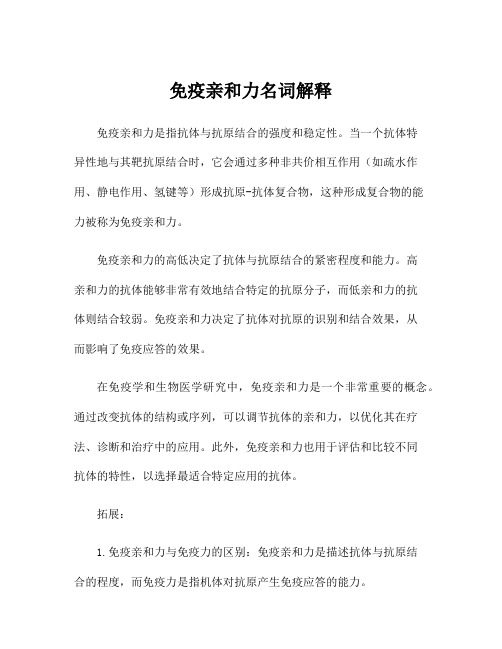
免疫亲和力名词解释
免疫亲和力是指抗体与抗原结合的强度和稳定性。
当一个抗体特
异性地与其靶抗原结合时,它会通过多种非共价相互作用(如疏水作用、静电作用、氢键等)形成抗原-抗体复合物,这种形成复合物的能
力被称为免疫亲和力。
免疫亲和力的高低决定了抗体与抗原结合的紧密程度和能力。
高
亲和力的抗体能够非常有效地结合特定的抗原分子,而低亲和力的抗
体则结合较弱。
免疫亲和力决定了抗体对抗原的识别和结合效果,从
而影响了免疫应答的效果。
在免疫学和生物医学研究中,免疫亲和力是一个非常重要的概念。
通过改变抗体的结构或序列,可以调节抗体的亲和力,以优化其在疗法、诊断和治疗中的应用。
此外,免疫亲和力也用于评估和比较不同
抗体的特性,以选择最适合特定应用的抗体。
拓展:
1.免疫亲和力与免疫力的区别:免疫亲和力是描述抗体与抗原结
合的程度,而免疫力是指机体对抗原产生免疫应答的能力。
2.抗体工程中的亲和力成熟过程:经过体外和体内的选择和筛选,科学家可以通过引入多个点突变或整体改造抗体的变异体,来提高或
降低其亲和力,以获得更理想的抗体药物。
3.免疫亲和力在疾病诊断中的应用:由于抗体与抗原结合的高亲
和力,免疫亲和力被广泛用于体外诊断方法,如酶联免疫吸附测定(ELISA),用于检测疾病标志物、病原体等。
图解抗原抗体反应类型和原理
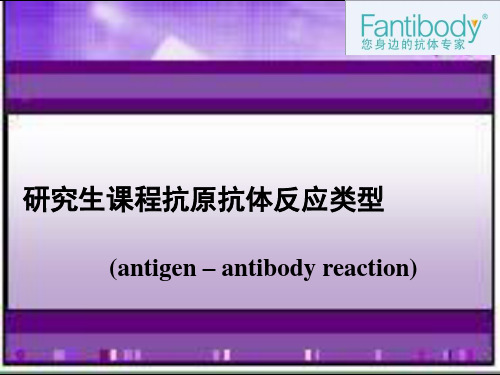
四、疏水作用力(疏水键)
• 概念:两个疏水基团在水溶液中相互接触时,由 于对水分子排斥而趋向聚集的力。
• 抗原决定簇与抗体上 的结合点靠近,互相间 正、负极性消失,亲水 层立即失去。
• 结合力最强,约占总 结合力的50%。
三、亲水胶体转化为疏水胶体
第一节 抗原抗体反应的原理
一、抗原抗体的亲和力和亲合力
* 亲和力(affinity):是抗体分 子上一个抗原结合点与相应的抗原 决定簇之间的相适应而结合的强度, 是抗原与抗体间固有的结合力。
抗体与抗原结合是可逆的反应,在平衡时其
亲和常数(K):
K值越大⇨抗体的亲和力越高⇨与抗原结合越牢固
亲合力(avidity):是指一个抗体分子 与整个抗原表位之间结合的强度,与抗 体结合价直接相关。另外也与亲和力强 弱有关。
• 结合力的大小与两个相 互作用基团的极化程度的 乘积成正比、与它们之间 距离的7次方成反比。 • 作用大小取决于二者分 子空间构型的互补性
• 作用力最小
三、氢键结合力
• 概念:供氢体上的氢原子与受氢体原子间的引力。 • 供氢体:-COOH、-NH2和-OH • 受氢体:氧、氮
氢键结合力与供氢体和受氢体之间距离的6次方成反比。
后代(postzone)抗原过量时称为。
四、阶段性
第一阶段:抗原与抗体发生特异 性结合阶段
特点:反应快 第二阶段:反应可见阶段
特点:反应时间较长
第三节 抗原抗体反应影响因素
一、反应物自身因素 *抗原:理化特性、Ag决定簇数量和种类。 *抗体: 1、来源(如:R型抗体 > H型抗体) 2、特异性与亲和力(如:单克隆抗体) 3、浓度
图解抗原抗体反应类型和原理
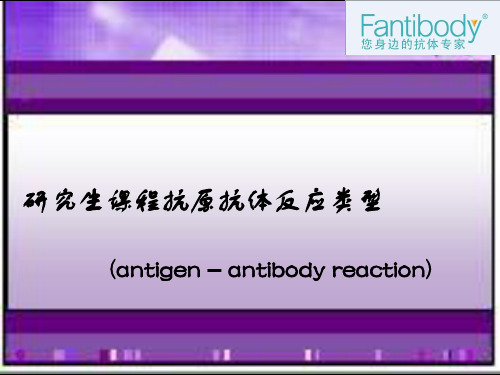
4、决定抗原抗体解离的因素
(1)抗体与相应抗原的亲合力。 亲合力低的抗体与抗原形成的复合物较易解离。
(2)环境因素对复合物的影响。 PH过高或过低、增加离子强度均可破坏
静电引力,使抗原抗体结合力下降,促使其 解离。
注意:解离后的抗原或抗体仍然保持其原有生物活性
精品课件
三、比例性(proportionality)
概念:两种不同的抗原分子具有部分相同或类似结 构的抗原表位,可与彼此相应的抗血清发生反应。
B
抗原抗体交叉反应示意图 精品课件
二、可逆性(reversibility)
1、概念:是指抗原与相应抗体结合成复合物后,在 一定条件下可解离为游离抗原与抗体的特 性称为抗原抗体结合的可逆性。
2、原因:抗原抗体的结合是分子表面的非共价键 结合,因此形成的复合物不牢固。 3、抗原抗体反应动态平衡式如下:
为亲水胶体。
复合物成为疏水胶体
精品课件
可见反应
在电解质作用下,中 和胶体粒子表面的电 荷,使各疏水胶体之 间靠拢,形成可见的 抗原抗体复合物
第二节 抗原抗体反应的特点
1.特异性 2.比例性 3.可逆性 4.阶段性
精品课件
一、 特异性(specificity)
1、概念:一种抗原分子通常只能与其刺激机体后
• 作用力最小
精品课件
三、氢键结合力
• 概念:供氢体上的氢原子与受氢体原子间的引力。 • 供氢体:-COOH、-NH2和-OH • 受氢体:氧、氮
➢ 氢键结合力与供氢体和受氢体之间距离的6次方成反比。
➢ 最具特异性(必须供氢体和受氢体互补才能实现氢键的结
合)
精品课件
四、疏水作用力(疏水键)
• 概念:两个疏水基团在水溶液中相互接触时,由于 对水分子排斥而趋向聚集的力。
抗体的亲和力与亲合力
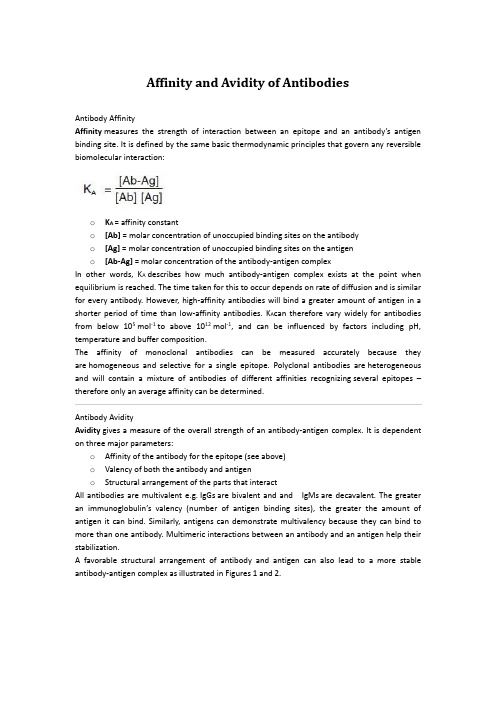
Affinity and Avidity of AntibodiesAntibody AffinityAffinity measures the strength of interaction between an epitope and an antibody’s antigen binding site. It is defined by the same basic thermodynamic principles that govern any reversible biomolecular interaction:o K A = affinity constanto[Ab] = molar concentration of unoccupied binding sites on the antibodyo[Ag] = molar concentration of unoccupied binding sites on the antigeno[Ab-Ag] = molar concentration of the antibody-antigen complexIn other words, K A describes how much antibody-antigen complex exists at the point when equilibrium is reached. The time taken for this to occur depends on rate of diffusion and is similar for every antibody. However, high-affinity antibodies will bind a greater amount of antigen in a shorter period of time than low-affinity antibodies. K A can therefore vary widely for antibodies from below 105 mol-1 to above 1012 mol-1, and can be influenced by factors including pH, temperature and buffer composition.The affinity of monoclonal antibodies can be measured accurately because they are homogeneous and selective for a single epitope. Polyclonal antibodies are heterogeneous and will contain a mixture of antibodies of different affinities recognizing several epitopes –therefore only an average affinity can be determined.Antibody AvidityAvidity gives a measure of the overall strength of an antibody-antigen complex. It is dependent on three major parameters:o Affinity of the antibody for the epitope (see above)o Valency of both the antibody and antigeno Structural arrangement of the parts that interactAll antibodies are multivalent e.g. IgGs are bivalent and and IgMs are decavalent. The greater an immunoglobulin’s valency (number of antigen binding sites), the greater the amoun t of antigen it can bind. Similarly, antigens can demonstrate multivalency because they can bind to more than one antibody. Multimeric interactions between an antibody and an antigen help their stabilization.A favorable structural arrangement of antibody and antigen can also lead to a more stable antibody-antigen complex as illustrated in Figures 1 and 2.Figure 1. An immobilized antigen (a high local concentration of available epitopes) provides more opportunity for the antibody-antigen complex to form than free antigen in solution over the same time period. Once the first antigen binding arm of an antibody attaches to an antigen on a solid support, the chances of a bivalent interaction are greatly improved. Many immunoassays like Western blotting and ELISA exploit this principle.Figure 2. When an antigen is mixed with a polyclonal antibody, multivalent interactions may lead to large, stable (high avidity) structures being formed. This is because the antigen may be bound by several antibodies, each recognizing a different epitope. Polyclonal antibodies are therefore ideal for immunoprecipitation experiments.进一步阅读Further Useful ReadingHow we improve the affinity of our recombinant monoclonal antibodies generated using HuCAL technology through affinity maturation。
- 1、下载文档前请自行甄别文档内容的完整性,平台不提供额外的编辑、内容补充、找答案等附加服务。
- 2、"仅部分预览"的文档,不可在线预览部分如存在完整性等问题,可反馈申请退款(可完整预览的文档不适用该条件!)。
- 3、如文档侵犯您的权益,请联系客服反馈,我们会尽快为您处理(人工客服工作时间:9:00-18:30)。
Affinity and Avidity of Antibodies
Antibody Affinity
Affinity measures the strength of interaction between an epitope and an antibody’s antigen binding site. It is defined by the same basic thermodynamic principles that govern any reversible biomolecular interaction:
o K A= affinity constant
o[Ab]= molar concentration of unoccupied binding sites on the antibody
o[Ag]= molar concentration of unoccupied binding sites on the antigen
o[Ab-Ag]= molar concentration of the antibody-antigen complex
In other words, K A describes how much antibody-antigen complex exists at the point when equilibrium is reached. The time taken for this to occur depends on rate of diffusion and is similar for every antibody. However, high-affinity antibodies will bind a greater amount of antigen in a shorter period of time than low-affinity antibodies. K A can therefore vary widely for antibodies from below 105mol-1to above 1012mol-1, and can be influenced by factors including pH, temperature and buffer composition.
The affinity of monoclonal antibodies can be measured accurately because they are homogeneous and selective for a single epitope. Polyclonal antibodies are heterogeneous and will contain a mixture of antibodies of different affinities recognizing several epitopes – therefore only an average affinity can be determined.
Antibody Avidity
Avidity gives a measure of the overall strength of an antibody-antigen complex. It is dependent on three major parameters:
o Affinity of the antibody for the epitope (see above)
o Valency of both the antibody and antigen
o Structural arrangement of the parts that interact
All antibodies are multivalent e.g.IgGs are bivalent and and IgMs are decavalent. The greater an immunoglobulin’s valency (number of antigen binding sites), the greater the amount of antigen it can bind. Similarly, antigens can demonstrate multivalency because they can bind to more than one antibody. Multimeric interactions between an antibody and an antigen help their stabilization.
A favorable structural arrangement of antibody and antigen can also lead to a more stable antibody-antigen complex as illustrated in Figures 1 and 2.
Figure 1.An immobilized antigen (a high local concentration of available epitopes) provides more opportunity for the antibody-antigen complex to form than free antigen in solution over the same time period. Once the first antigen binding arm of an antibody attaches to an antigen on a solid support, the chances of a bivalent interaction are greatly improved. Many immunoassays like Western blotting and ELISA exploit this principle.
Figure 2.When an antigen is mixed with a polyclonal antibody, multivalent interactions may lead to large, stable (high avidity) structures being formed. This is because the antigen may be bound by several antibodies, each recognizing a different epitope. Polyclonal antibodies are therefore ideal for immunoprecipitation experiments.
Further Useful Reading
How we improve the affinity of our recombinant monoclonal antibodies generated using HuCAL technology through affinity maturation。
